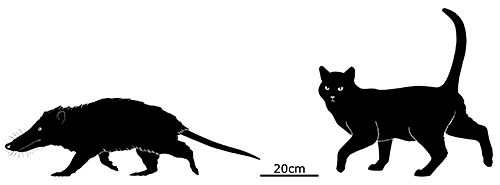Thanks to the absence of large terrestrial carnivores on the Gargano-Scontrone island(s) during the Late Miocene, animals that were usually small had the opportunity to become larger, moving into the vacant ecological niches and evolving into predators unlike anything existing on the mainland.
Deinogalerix was a giant member of the gymnures – close relatives of hedgehogs without the quills – with a proportionally big head and a long snout full of large fangs at the front and bone-crushing molars at the back.
Several different species have been found, with the largest Deinogalerix koenigswaldi having a head-and-body length of around 60cm (2′). Along with its tail that would have made it at least 90cm long (2′11″), making it the biggest eulipotyphlan ever discovered.
It would probably have hunted smaller mammals, birds, and reptiles, filling a niche on the island similar to dogs or cats.


